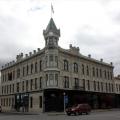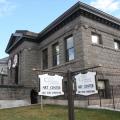Hiking, history and heritage, that’s the theme of the Oregon Trial Interpretive Center just East of Baker City.
Cities: Baker City
« Back to Cities & Regions
In 1861, Henry Griffin found gold near the Powder River, and the rush was on. Boomtowns like Sumpter, Bourne, and Auburn sprouted overnight. Within 20 years Baker City developed into the commerce and cultural hub of the region. By 1900, elegant hotels, an opera house, trolleys, electricity and telephone service had transformed Baker City into the largest town between Salt Lake City and Portland.
Despite being a town of just over 10,000 residents, Baker City feels significantly larger – an if you look into its history, you can understand why.
Region: Eastern Oregon
Ginger Savage, executive director of the Crossroads Carnegie Art Center, knows the minute someone walks up the stairs, whether they are there to enjoy the artwork, or the architecture of her building.
Region: Eastern Oregon


